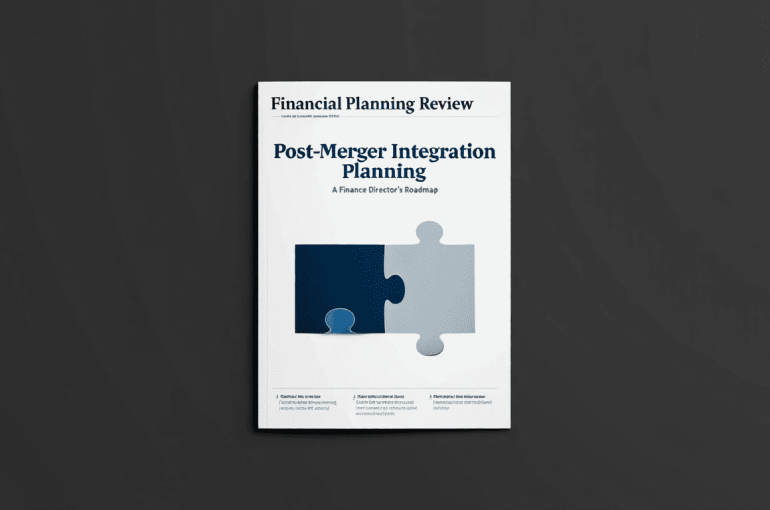Post-Merger Integration Planning: A Finance Director’s Roadmap

The successful conclusion of a merger or acquisition is a significant milestone for any organization, but it’s the post-merger integration (PMI) phase that truly determines the long-term success of the transaction. For Finance Directors (FDs), the PMI phase is critical. It involves the meticulous merging of financial operations, systems, and cultures to realize the expected synergies and benefits of the merger or acquisition. Here’s a comprehensive guide on how FDs should approach post-merger integration planning.
Establish Clear Integration Objectives
1. Define Success Metrics: Start with a clear definition of what success looks like for the integration process. This could include financial targets, operational efficiency goals, or customer retention rates. Having clear metrics helps in monitoring progress and aligning efforts across the organization.
2. Prioritize Integration Activities: Not all integration activities are created equal. FDs should work with senior management to prioritize initiatives that will drive the most value for the combined entity. This may involve focusing on integrating core financial processes, systems, and reporting structures first.
Financial Systems and Processes Integration
3. Harmonize Accounting Policies: One of the first steps is to harmonize accounting policies and practices between the merging entities. This ensures consistency in financial reporting and compliance with regulatory requirements.
4. Consolidate Financial Systems: Integrating financial systems is a complex but crucial task. FDs should oversee the consolidation of ERP systems, financial planning and analysis tools, and other financial software to ensure seamless data flow and reporting capabilities.
5. Streamline Financial Operations: Look for opportunities to streamline operations and eliminate redundancies. This might involve centralizing functions like accounts payable and receivable, payroll, and procurement to achieve cost efficiencies and simplify processes.
Managing Cultural and Operational Integration
6. Address Cultural Integration: Cultural assimilation is often one of the most challenging aspects of PMI. FDs should work with HR to identify cultural differences and develop programs to foster a unified corporate culture. This includes clear communication, team-building initiatives, and leadership development programs.
7. Ensure Transparent Communication: Keeping employees informed throughout the integration process helps to mitigate uncertainty and resistance to change. FDs should ensure that communication is frequent, transparent, and addresses the concerns of stakeholders across both organizations.
Strategic and Regulatory Considerations
8. Align on Strategic Vision: The FD plays a key role in aligning the strategic visions of the merging entities. This involves setting financial goals that support the overall business strategy and ensuring that financial planning reflects the combined entity’s objectives.
9. Ensure Compliance and Risk Management: Post-merger, the regulatory and compliance landscape can become more complex. FDs need to ensure that the integrated entity adheres to all legal and regulatory requirements, assessing risks and implementing controls as necessary.
Leveraging Technology and Data
10. Invest in Technology and Data Analytics: To drive efficiency and insights in the integrated entity, FDs should advocate for investments in technology and data analytics. This includes tools for financial modeling, performance tracking, and decision support to enable data-driven management.
In the modern business landscape, technology and data analytics have emerged as pivotal elements in enhancing operational efficiency, strategic decision-making, and competitive edge. For Finance Directors (FDs), advocating for and investing in the right technological tools and analytics capabilities is crucial to fostering a data-driven culture within the organization. This approach not only streamlines financial operations but also provides deep insights that inform strategic decisions. Here’s how FDs should navigate investing in technology and data analytics to maximize benefits for the integrated entity post-merger or acquisition.
Identifying the Right Technologies
1. Assess Needs and Goals: Before investing, FDs should conduct a thorough assessment of the organization’s needs and the strategic goals technology aims to support. This includes identifying inefficiencies in current processes, areas where data analytics could provide strategic insights, and overall technology infrastructure needs.
2. Prioritize Scalable Solutions: In selecting technologies, prioritize solutions that are scalable and can grow with the organization. Cloud-based ERP systems, for example, can be scaled easily and offer the flexibility needed to accommodate the evolving needs of a dynamic business environment.
3. Focus on Integration Capabilities: Given the complexity of financial systems, particularly in a post-merger scenario, FDs should invest in technologies with strong integration capabilities. This ensures seamless data flow across different platforms and departments, facilitating comprehensive analysis and reporting.
Leveraging Data Analytics for Strategic Insights
4. Implement Advanced Analytics Tools: Advanced analytics and business intelligence tools can transform raw data into actionable insights. FDs should champion the implementation of these tools to enable detailed performance analysis, trend forecasting, and predictive modeling.
5. Foster a Data-Driven Culture: Beyond just implementing tools, FDs should work towards fostering a data-driven culture within the organization. This involves training teams on data literacy, encouraging data-driven decision-making, and demonstrating how analytics can support strategic objectives.
6. Enhance Decision Support Systems: Invest in decision support systems that aggregate data from various sources to provide a holistic view of the business. These systems can assist FDs and other executives in making informed strategic decisions by presenting relevant data and predictive insights.
Driving Efficiency Through Automation
7. Automate Financial Processes: Automation technologies can significantly improve the efficiency of financial operations by reducing manual tasks, minimizing errors, and speeding up reporting cycles. FDs should identify processes that are ripe for automation, such as accounts payable/receivable, payroll, and financial reconciliation.
8. Streamline Reporting and Compliance: Technology can also streamline reporting and ensure compliance with regulatory requirements. Automated reporting systems can generate financial reports quickly and accurately, while compliance management tools can help monitor changes in regulations and ensure the organization remains compliant.
Building a Foundation for Continuous Improvement
9. Continuous Monitoring and Optimization: Technology and analytics investments should not be static. FDs should establish continuous monitoring mechanisms to assess the effectiveness of these tools and identify areas for further improvement or optimization.
10. Stay Informed on Technological Advancements: The technological landscape is constantly evolving. FDs should stay informed about new technologies, analytics capabilities, and best practices to ensure the organization continues to leverage the most effective tools available.
Investing in technology and data analytics is not merely a matter of upgrading systems but is a strategic initiative that can redefine how an organization operates and competes. For Finance Directors, leading this charge by advocating for smart technology investments and fostering a culture that values data-driven insights is essential for driving efficiency, enhancing strategic decision-making, and achieving long-term success. By carefully selecting technologies, leveraging analytics for insights, and promoting continuous improvement, FDs can ensure their organizations are well-positioned to navigate the complexities of the modern business environment.
Continuous Improvement and Optimization
11. Monitor Performance and Optimize Continuously: Post-merger integration is not a one-time task but a continuous process. FDs should establish mechanisms for monitoring performance against the integration objectives and adjusting strategies as needed. This involves regular review meetings, performance dashboards, and feedback loops to identify and implement improvements.
Conclusion
Post-merger integration planning is a complex, multifaceted process that requires strategic foresight, meticulous planning, and strong leadership from the Finance Director. By focusing on financial integration, cultural assimilation, strategic alignment, and continuous optimization, FDs can play a pivotal role in ensuring the merger or acquisition achieves its intended goals and delivers sustainable value to stakeholders. The successful integration of merging entities is a testament to the FD’s capability to navigate complex challenges and steer the organization towards a prosperous future.
If you are looking for a new FD for your business make sure to reach out to FD Capital who are the leaders in senior Finance recruitment particularly for London and the South East.
Related posts:

Adrian Lawrence FCA with over 25 years of experience as a finance leader and a Chartered Accountant, BSc graduate from Queen Mary College, University of London.
I help my clients achieve their growth and success goals by delivering value and results in areas such as Financial Modelling, Finance Raising, M&A, Due Diligence, cash flow management, and reporting. I am passionate about supporting SMEs and entrepreneurs with reliable and professional Chief Financial Officer or Finance Director services.













